Review of the Heat Flow Mapping in Polish Sedimentary Basin across Different Tectonic Terrains
Abstract
:1. Introduction
2. The Tectonic Background
3. Historical Evolution of Heat Flow Maps of Poland—Materials and Methods
- (1)
- averaging the measurement made on core samples from the interval;
- (2)
- using the mean values for stratigraphic lithologic layers calculated for a large territory by numerous borehole data;
- (3)
- building a geophysical log-based model of the volume of number “i“ of rock components with l i-thermal conductivity of mineral components from tables, Vi-volume of component “i“ and porosity.
4. Heat Flow at the Base of Sediments (at the Consolidated Basement) and at the Moho
5. Polish Heat Flow in the European Map Context
6. Discussion
7. Conclusions
Funding
Institutional Review Board Statement
Informed Consent Statement
Data Availability Statement
Acknowledgments
Conflicts of Interest
References
- Blackwell, D.D. Geothermal Resource Base Assessment the Future of Geothermal Energy: Impact of Enhanced Geothermal Systems (EGS) on the United States in the 21st Century; Tester, J.W., Ed.; MIT Press: Cambridge, MA, USA, 2006. [Google Scholar]
- Rybach, L. The Future of Geothermal Energy and its Challenges. In Proceedings of the World Geothermal Congress 2010, Bali, Indonesia, 25–29 April 2010. [Google Scholar]
- Tester, J.W.; Reber, T.; Beckers, K.; Lukawski, M.; Camp, E.; Andrea, G.; Aguirre, A.; Jordan, T.; Horowitz, F. Integrating Geothermal Energy Use into Re-building American Infrastructure. In Proceedings of the World Geothermal Congress 2015, Melbourne, Australia, 19–25 April 2015. [Google Scholar]
- Younger, P.L. Geothermal Energy: Delivering on the Global Potential. Energies 2015, 8, 11737–11754. [Google Scholar] [CrossRef] [Green Version]
- Guterch, A.; Grad, M.; Keller, R.; Polonaise Working Group. Huge contrasts of the lithospheric structure revealed by new generation seismic experiments in Central Europe. Prz. Geol. 2004, 52, 753–760. [Google Scholar]
- Karnkowski, P.H. Tectonic subdivision of Poland: Polish lowlands. Prz. Geol. 2008, 56, 895–903, (In Polish with English abstract). [Google Scholar]
- Grad, M.; Polkowski, M. Seismic basement in Poland. Acta Diabetol. 2015, 105, 1199–1214. [Google Scholar] [CrossRef] [Green Version]
- Majorowicz, J. Terrestrial heat-flow and geothermal gradient in north-east Poland. Acta Geophys. Pol. 1972, 20, 131–141. [Google Scholar]
- Majorowicz, J. Heat flow in Poland and its relation to the geological structure. Geothermics 1973, 2, 24–28. [Google Scholar] [CrossRef]
- Dowgiałło, J. The Sudetic geothermal region of Poland. Geothermics 2002, 31, 343–359. [Google Scholar] [CrossRef]
- Gordienko, V.V.; Zavgorodnyaya, O.V. Estimation of heat flow in Poland. Acta Geophys. Pol. 1996, 44, 173–181. [Google Scholar]
- Karwasiecka, A.M.; Bruszewska, B. Density of the surface Earth’s heat flow on the area of Poland (Gęstość poerzchniowego strumienia cieplnego ziemi na obszarze Polski). Centr. Arch. PIG Pol. Geol. Inst. 1997, 60, 21–98. (In Polish) [Google Scholar]
- Majorowicz, J.; Šafanda, J.; Torun-1 Working Group. Heat flow variation with depth in Poland: Evidence from equilibrium temperature logs in 2.9-km-deep well Torun-1. Int. J. Earth Sci. 2008, 97, 307–315. [Google Scholar] [CrossRef]
- Majorowicz, J.; Plewa, S. Study of heat flow in Poland with special regards to tectonophysical problems. In Terrestrial Heat Flow in Europe; Čermak, V., Rybach, L., Eds.; Springer: Berlin/Heidelberg, Germany; New York, NY, USA, 1979; pp. 240–252. [Google Scholar]
- Plewa, S. Rozkład Parametrów Geotermalnych na Obszarze Polski; Wydawnictwo CPPGSMiE PAN: Kraków, Poland, 1998; 138p. [Google Scholar]
- Puziewicz, J.; Czechowski, L.; Grad, M.; Majorowicz, J.; Pietranik, A.; Šafanda, J. Crustal lithology vs. thermal state and Moho heat flow across the NE part of the European Variscan orogen: A case study from SW Poland. Acta Diabetol. 2019, 108, 673–692. [Google Scholar] [CrossRef] [Green Version]
- Szewczyk, J.; Gientka, D. Terrestrial heat flow density in Poland—A new approach. Geol. Q. 2009, 53, 125–140. [Google Scholar]
- Majorowicz, J.; Polkowski, M.; Grad, M. Thermal properties of the crust and the lithosphere–asthenosphere boundary in the area of Poland from the heat flow variability and seismic data. Int. J. Earth Sci. 2019, 108, 649–672. [Google Scholar] [CrossRef] [Green Version]
- Żelaźniewicz, A.; Aleksandrowski, P.; Buła, Z.; Karnkowski, P.H.; Konon, A.; Oszczypko, N.; Ślączka, A.; Żaba, J.; Żytko, K. Tectonic Subdivision of Poland; KNG PAN: Wrocław, Poland, 2011; pp. 1–60. (In Polish) [Google Scholar]
- Artemieva, I.; Mooney, W.D. Thermal thickness and evolution of Precambrian lithosphere: A global study. J. Geophys. Res. Space Phys. 2001, 106, 16387–16414. [Google Scholar] [CrossRef] [Green Version]
- Grad, M.; Polkowski, M.; Ostaficzuk, S.R. High-resolution 3D seismic model of the crustal and uppermost mantle structure in Poland. Tectonophysics 2016, 666, 188–210. [Google Scholar] [CrossRef]
- Majorowicz, J.; Wybraniec, S. New terrestrial heat flow map of Europe after regional paleoclimatic correction application. Acta Diabetol. 2010, 100, 881–887. [Google Scholar] [CrossRef]
- Majorowicz, J.A. Heat Flow Data from Poland. Nat. Phys. Sci. 1973, 241, 16–17. [Google Scholar] [CrossRef]
- Majorowicz, J. Heat flow map of Poland on the background of geothermal field of Europe and some aspects of its interpretation. Acta Geophys. Pol. 1976, 24, 147–156. [Google Scholar]
- Wessel, P.; Smith, W.H.F. Free software helps map and display data. Eos 1991, 72, 441. [Google Scholar] [CrossRef]
- Majorowicz, J.; Šafanda, J. Lithosphere Thickness from New Heat-Flow Data of the Odra Variscan Area, S-W Poland. Pure Appl. Geophys. 2018, 175, 4343–4354. [Google Scholar] [CrossRef]
- Królikowski, C. Crustal-scale complexity of the contact zone between the Palaeozoic Platform and the East European Craton in the NW Poland. Geol. Q. 2006, 50, 33–42. [Google Scholar]
- Karnkowski, P.H. Petroleum Provinces in Poland. Prz. Geol. 2007, 55, 1061–1067, (In Polish with English abstract). [Google Scholar]
- Jessop, A.M.; Habart, M.A.; Sclater, J.G. The world heat flow data collection 1975. Geotherm. Serv. Can. Geotherm. Ser. 1976, 50, 55–77. [Google Scholar]
- Vieira, F.; Hamza, V. Global Heat Flow: New Estimates Using Digital Maps and GIS Techniques. Int. J. Terr. Heat Flow Appl. Geotherm. 2018, 1, 6–13. [Google Scholar]
- Kim, Y.; Huh, M.; Lee, E. Numerical Modelling to Evaluate Sedimentation Effects on Heat Flow and Subsidence during Continental Rifting. Geosciences 2020, 10, 451. [Google Scholar] [CrossRef]
- MacKenzie, J.M.; Canil, D. Composition and thermal evolution of cratonic mantle beneath the central Archean Slave Province, NWT, Canada. Contrib. Miner. Pet. 1999, 134, 313–324. [Google Scholar] [CrossRef]
- Heckenbach, E.; Norden, B.; Fuchs, S. Evaluation of the glacial impact on the shallow heat-flow density in the North German Basin. Geophys. Res. Abstr. 2019, 21. Available online: https://meetingorganizer.copernicus.org/EGU2019/EGU2019-12927-1.pdf (accessed on 7 September 2021).
- Cermak, V. Lithospheric thermal regimes in Europe. Phys. Earth Planet. Inter. 1993, 79, 179–193. [Google Scholar] [CrossRef]
- Cermak, V.; Safanda, J.; Guterch, A. Deep temperature distribution along three profiles crossing the Teisseyre-Tornquist tectonic zone in Poland. Tectonophysics 1989, 164, 151–163. [Google Scholar] [CrossRef]
- Hasterok, D.; Chapman, D. Heat production and geotherms for the continental lithosphere. Earth Planet. Sci. Lett. 2011, 307, 59–70. [Google Scholar] [CrossRef]
- Pollack, H.N.; Chapman, D.S. Mantle heat flow. Earth Planet. Sci. Lett. 1977, 34, 174–184. [Google Scholar] [CrossRef] [Green Version]
- Narkiewicz, M.; Grad, M.; Guterch, A.; Janik, T. Crustal seismic velocity structure of southern Poland: Preserved memory of a pre-Devonian terrane accretion at the East European Platform margin. Geol. Mag. 2010, 148, 191–210. [Google Scholar] [CrossRef]
- Artemieva, I.M. The Lithosphere: An Interdisciplinary Approach; Cambridge University Press: New York, NY, USA, 2011; p. 794. ISBN 9780521843966. [Google Scholar]
- Correia, A.; Šafanda, J. Geothermal modeling along a two-dimensional crustal profile in Southern Portugal. J. Geodyn. 2002, 34, 47–61. [Google Scholar] [CrossRef]
- Eppelbaum, L.V.; Kutasov, I.M.; Pilchin, A.N. Applied Geothermics; Springer: Berlin/Heidelberg, Germany, 2014. [Google Scholar]
- Jaupart, C.; Mareschal, J.-C. Constraints on crustal heat production from heat flow data. In Treatise on Geochemistry: The Crust; Rudnick, R., Ed.; Elsevier: Amsterdam, The Netherlands, 2003; Volume 3, pp. 65–84. [Google Scholar]
- Čermak, V.; Rybach, L. (Eds.) Terrestrial Heat Flow in Europe; Springer: Berlin/Heidelberg, Germany; New York, NY, USA, 1979; p. 328. [Google Scholar]
- Čermak, V.; Hurtig, E. Heat flow map of Europe, 1:5,000,000. In Terrestrial Heat Flow in Europe; Čermak, V., Rybach, L., Eds.; Springer: Berlin/Heidelberg, Germany; New York, NY, USA, 1979. [Google Scholar]
- Cloetingh, S.; van Wees, J.; Ziegler, P.; Lenkey, L.; Beekman, F.; Tesauro, M.; Förster, A.; Norden, B.; Kaban, M.; Hardebol, N. Lithosphere tectonics and thermo-mechanical properties: An integrated modelling approach for Enhanced Geothermal Systems exploration in Europe. Earth Sci. Rev. 2010, 102, 159–206. [Google Scholar] [CrossRef] [Green Version]
- Hurtig, E.; Čermak, V.; Haenel, R.; Zui, V.I. Geothermal atlas of Europe; Hermann Hack Verlagsgesellschaft: Geographisch-Kartographische Anstalt: Gotha, Germany, 1992. [Google Scholar]
- Guterch, A.; Wybraniec, S.; Grad, M.; Chadwick, R.A.; Krawczyk, C.M.; Ziegler, P.A.; Thybo, H.; De Vos, W. Crustal structure and structural framework. In Petroleum Geological Atlas of the Southern Permian Basin Area; Doornenbal, J.C., Stevenson, A.G., Eds.; EAGE Publications: Houten, The Netherlands, 2010; pp. 11–23. [Google Scholar]
- Fuchs, S. The variability of rock thermal properties in sedimentary basins and the impact on temperature modelling—A Danish example. Geothermics 2018, 76, 1–14. [Google Scholar] [CrossRef]
- Norden, B.; Förster, A.; Balling, N. Heat flow and lithospheric thermal regime in the Northeast German Basin. Tectonophysics 2008, 460, 215–229. [Google Scholar] [CrossRef] [Green Version]
- Marks, L. Timing of the Late Vistulian (Weichselian) glacial phases in Poland. Quat. Sci. Rev. 2012, 44, 81–88. [Google Scholar] [CrossRef]
- Wróblewska, M. Opracowanie modeli termicznych litosfery obszaru SE Polski. In Kompleksowa Interpretacja Anomalii Pól Potencjalnych Wzdłuż Wszystkich Profili Głębokich Badań Refrakcyjnych Zrealizowanych na Całym Obszarze CELEBRATTION 2000. Arch; Grad, M., Guterch, A., Eds.; Ministry of Environment: Warsaw, Poland, 2008. [Google Scholar]
- Simmons, N.A.; Forte, A.; Boschi, L.; Grand, S.P. GyPSuM: A joint tomographic model of mantle density and seismic wave speeds. J. Geophys. Res. Space Phys. 2010, 115. [Google Scholar] [CrossRef]
- Šimonová, B.; Zeyen, H.; Bielik, M. Continental lithospheric structure from the East European Craton to the Pannonian Basin based on integrated geophysical modelling. Tectonophysics 2018, 750, 289–300. [Google Scholar] [CrossRef]
- Bellani, S. Update of Heat Flow Data in the Geothermal Areas of Tuscany, Italy. GRC Trans. 2018, 42, 861–870. [Google Scholar]
- Szuman, I.; Kalita, J.Z.; Ewertowski, M.W. The impact of geothermal heat flux on the last Scandinavian ice sheet over W Poland and E Germany. Geogr. Ann. Ser. A Phys. Geogr. 2018, 100, 388–403. [Google Scholar] [CrossRef]
- Chapman, D.S.; Furlong, K.P. Thermal state of the continental lower crust. In Continental Lower Crust; Fountain, D.M., Arculus, R., Kay, R.W., Eds.; Elsevier: Amsterdam, The Netherlands, 1992; pp. 179–199. [Google Scholar]
- Lüthgens, C.; Böse, M. Chronology of Weichselian main ice marginal positions in north-eastern Germany. E G Quat. Sci. J. 2011, 60, 236–247. [Google Scholar] [CrossRef]
- Schlosser, P. Einbeziechung petrophysikalisher bohr-lochmesergebnisse in bestimmungen des terrestrischen warmeflusses. Geophys. Geol 1970, 15, 13–32. [Google Scholar]
- Agemar, T.; Weber, J.; Schulz, R. Deep Geothermal Energy Production in Germany. Energies 2014, 7, 4397–4416. [Google Scholar] [CrossRef]
- Barker, C. Thermal Modeling of Petroleum Generation: Theory and Applications. In Developments in Petroleum Science 45; Elsevier: Amsterdam, The Netherlands, 1976; p. 512. [Google Scholar]
- Griffiths, C.M.; Brereton, N.R.; Beausillon, R.; Castillo, D. Thermal conductivity prediction from petrophysical data: A case study. Geol. Soc. London, Spéc. Publ. 1992, 65, 299–315. [Google Scholar] [CrossRef]
- Blackwell, D.D.; Steele, J.L. Thermal conductivity of sedimentary rocks: Measurement and significance. In Thermal History of Sedimentary Basins, Methods and Case Histories; Naeser, N.D., McCulloh, T.M., Eds.; Springer: Berlin/Heidelberg, Germany; New York, NY, USA, 1989. [Google Scholar]
- Blackwell, D.D.; Richards, M. (Eds.) Heat Flow Map of North America, 1st ed.; AAPG: Tulsa, OK, USA, 2004; ISBN 0791815722. [Google Scholar]
- Blackwell, D.D.; Beardsmore, G.R.; Nishimori, R.K.; McMullen, R.J. High-Resolution Temperature Logs in a Petroleum Setting: Examples and Applications. Geotherm. Basin Anal. 1999, 1–34. [Google Scholar] [CrossRef]
- Wilde-Piórko, M.; Świeczak, M.; Grad, M.; Majdański, M. Integrated seismic model of the crust and upper mantle of the Trans-European Suture zone between the Precambrian craton and Phanerozoic terranes in Central Europe. Tectonophysics 2010, 481, 108–115. [Google Scholar] [CrossRef]
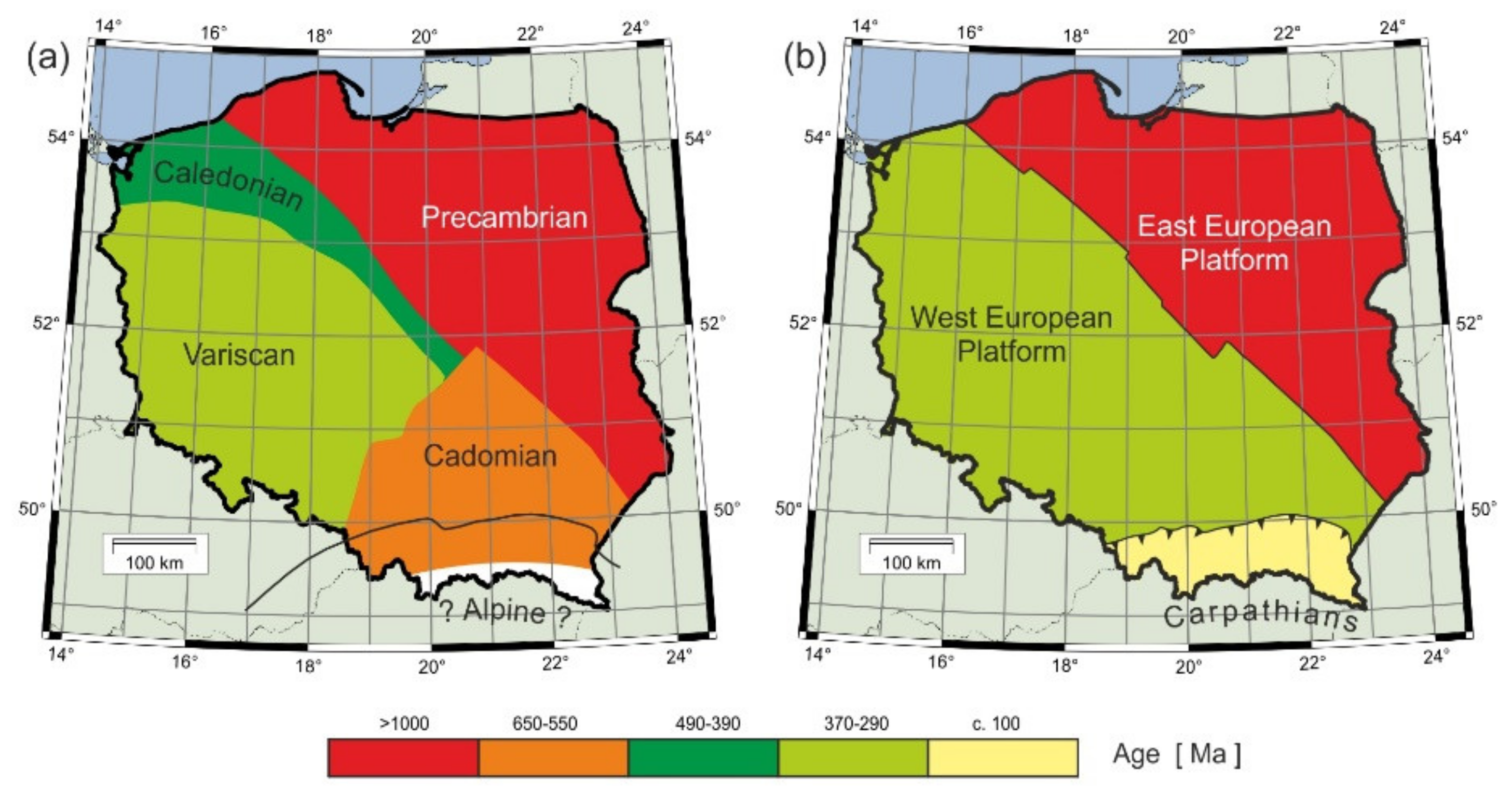
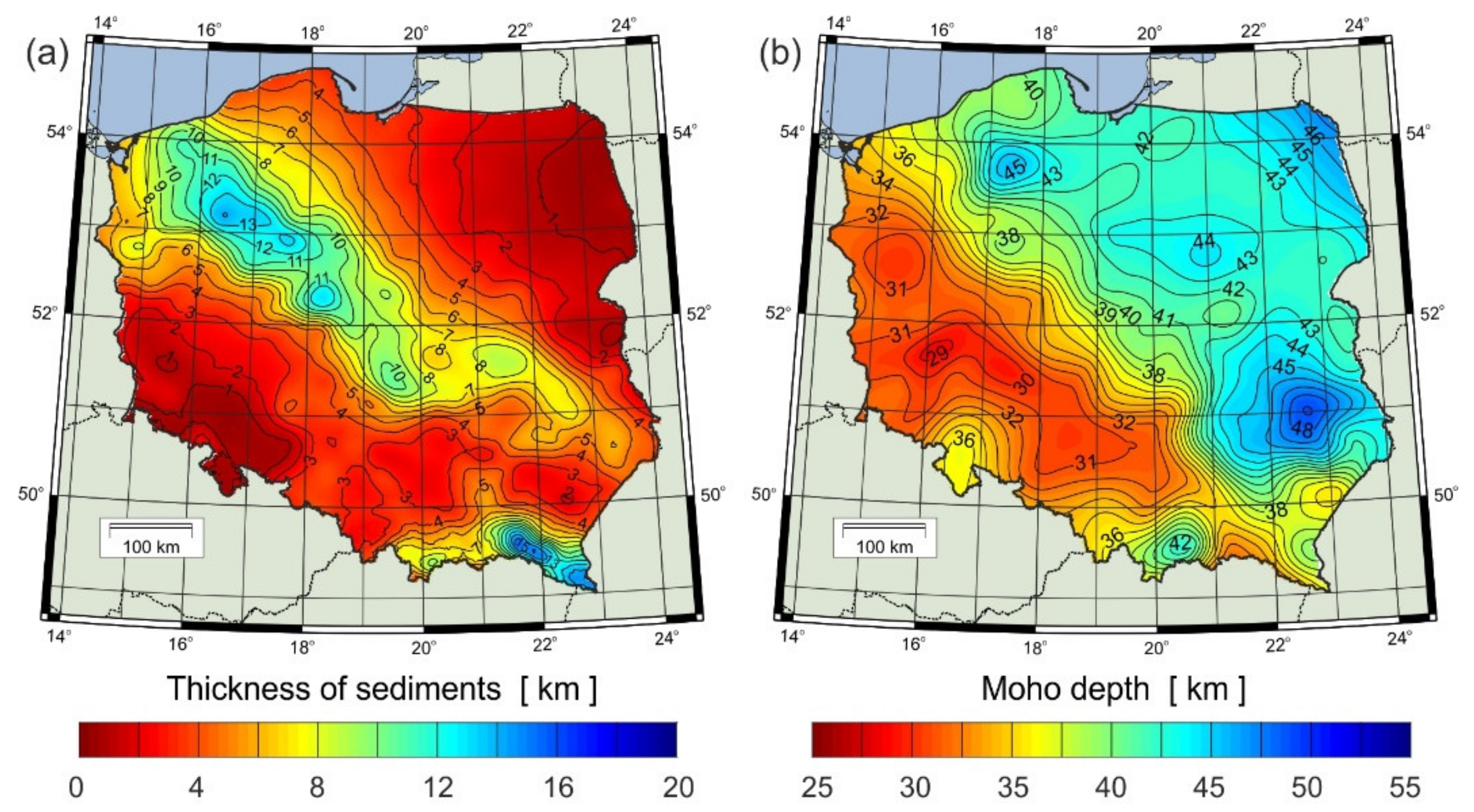

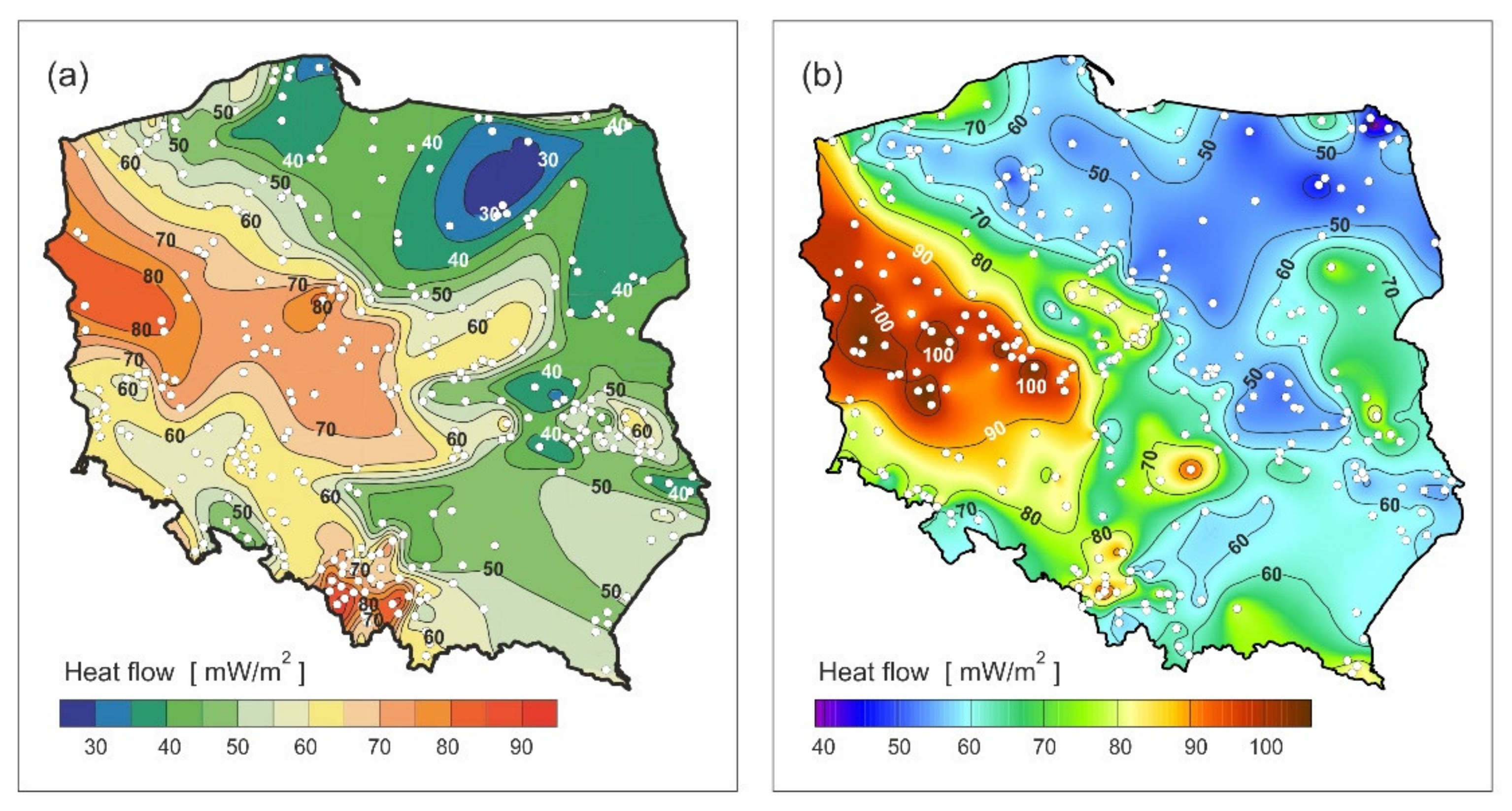
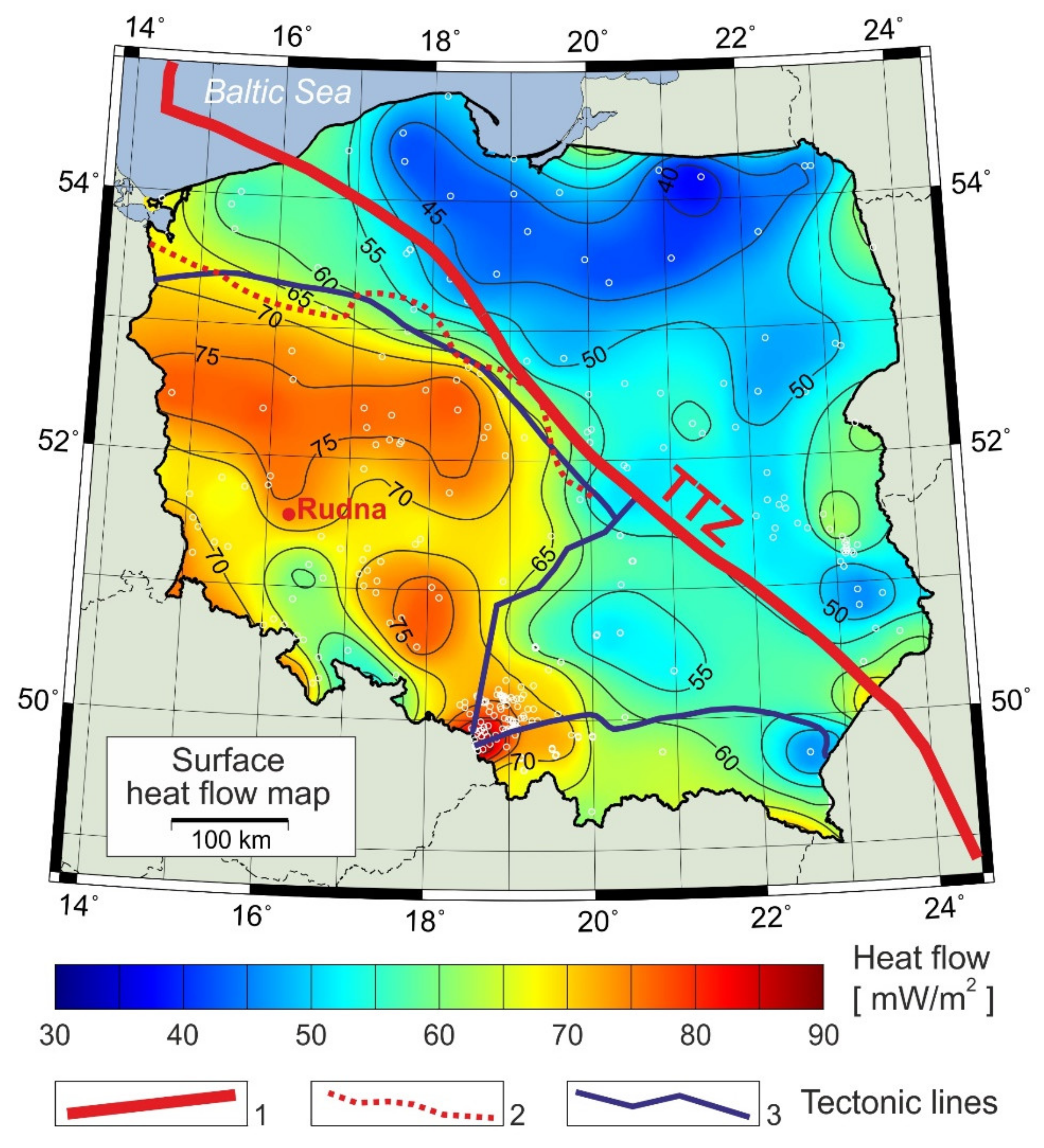
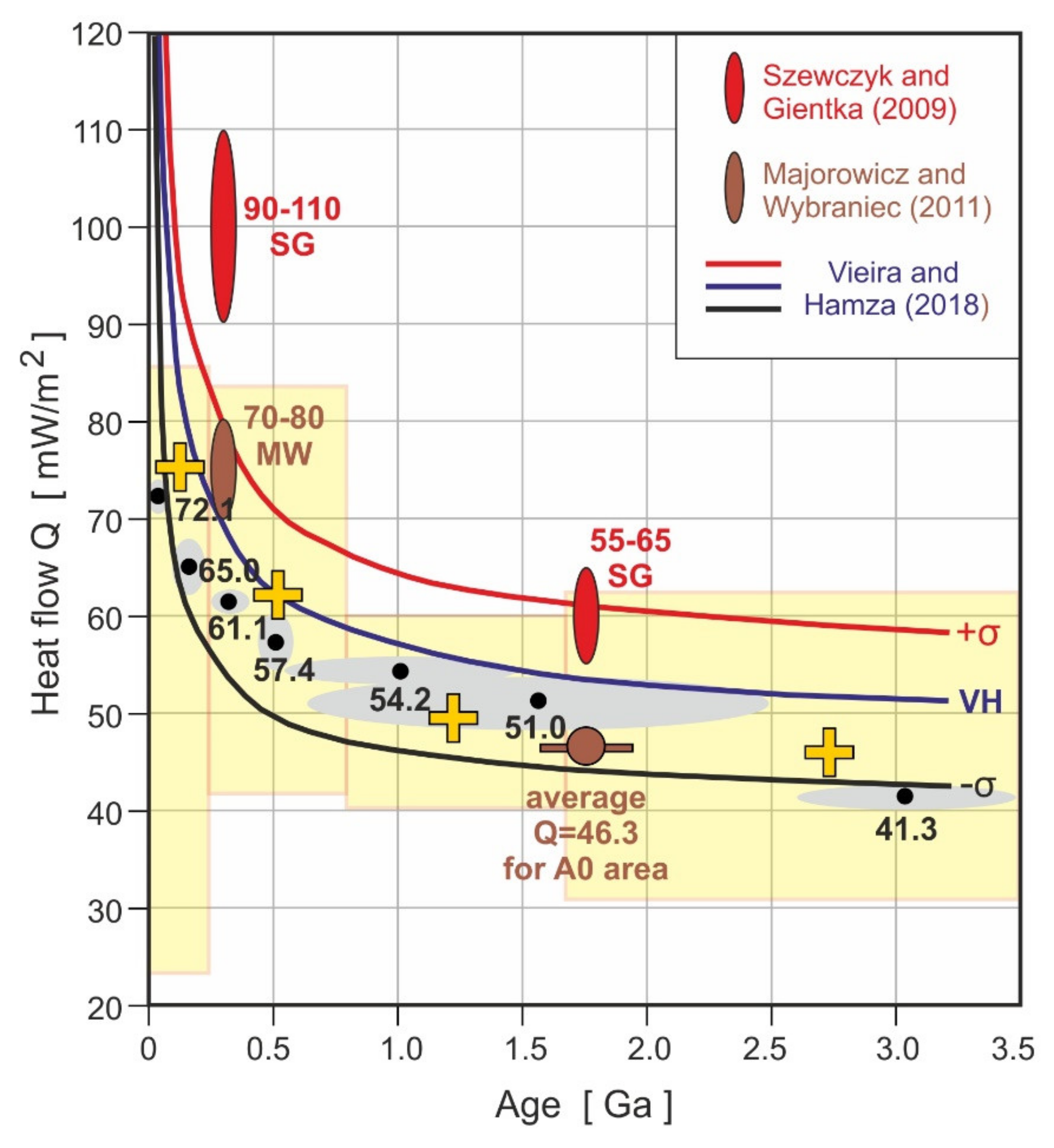
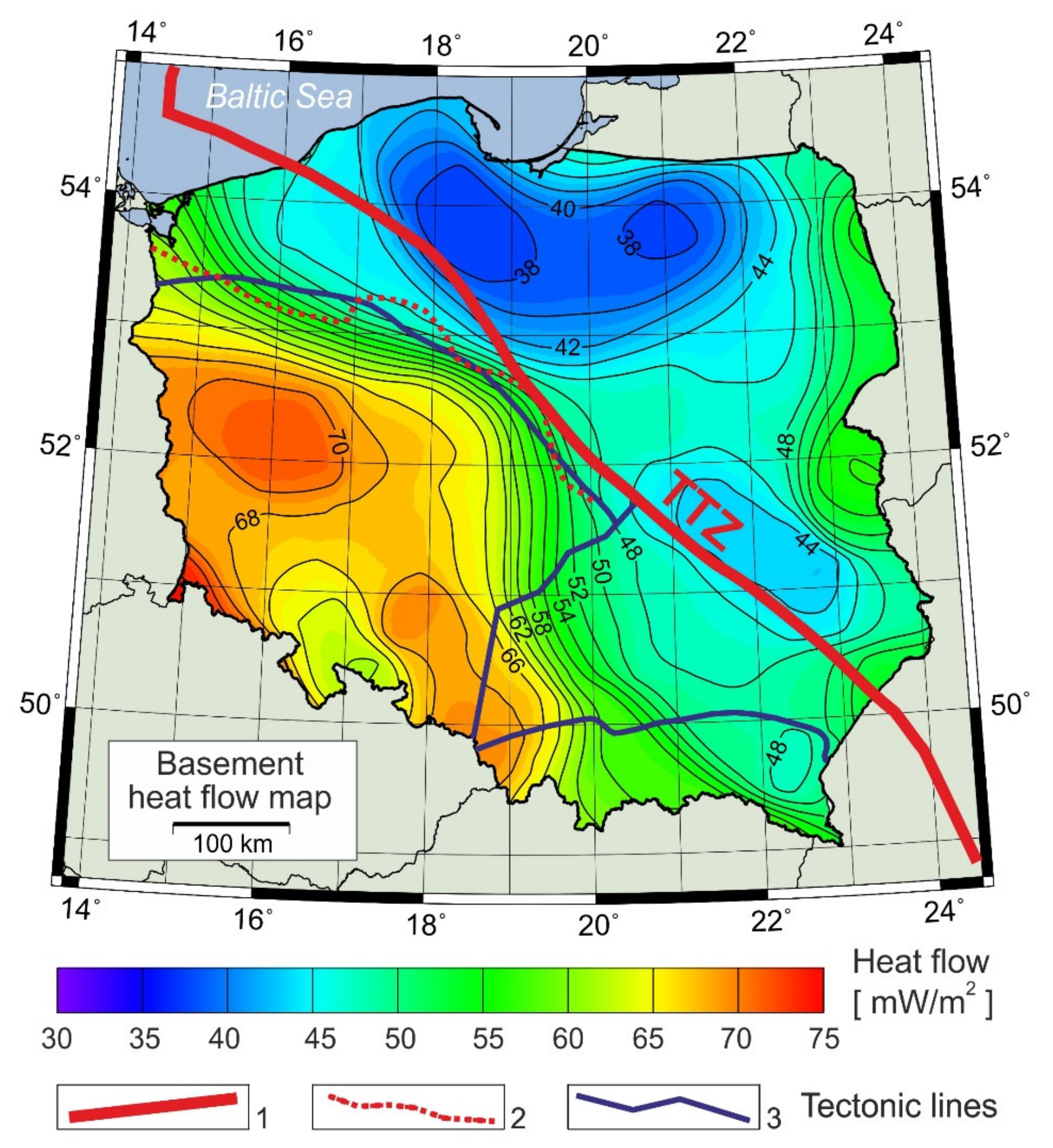
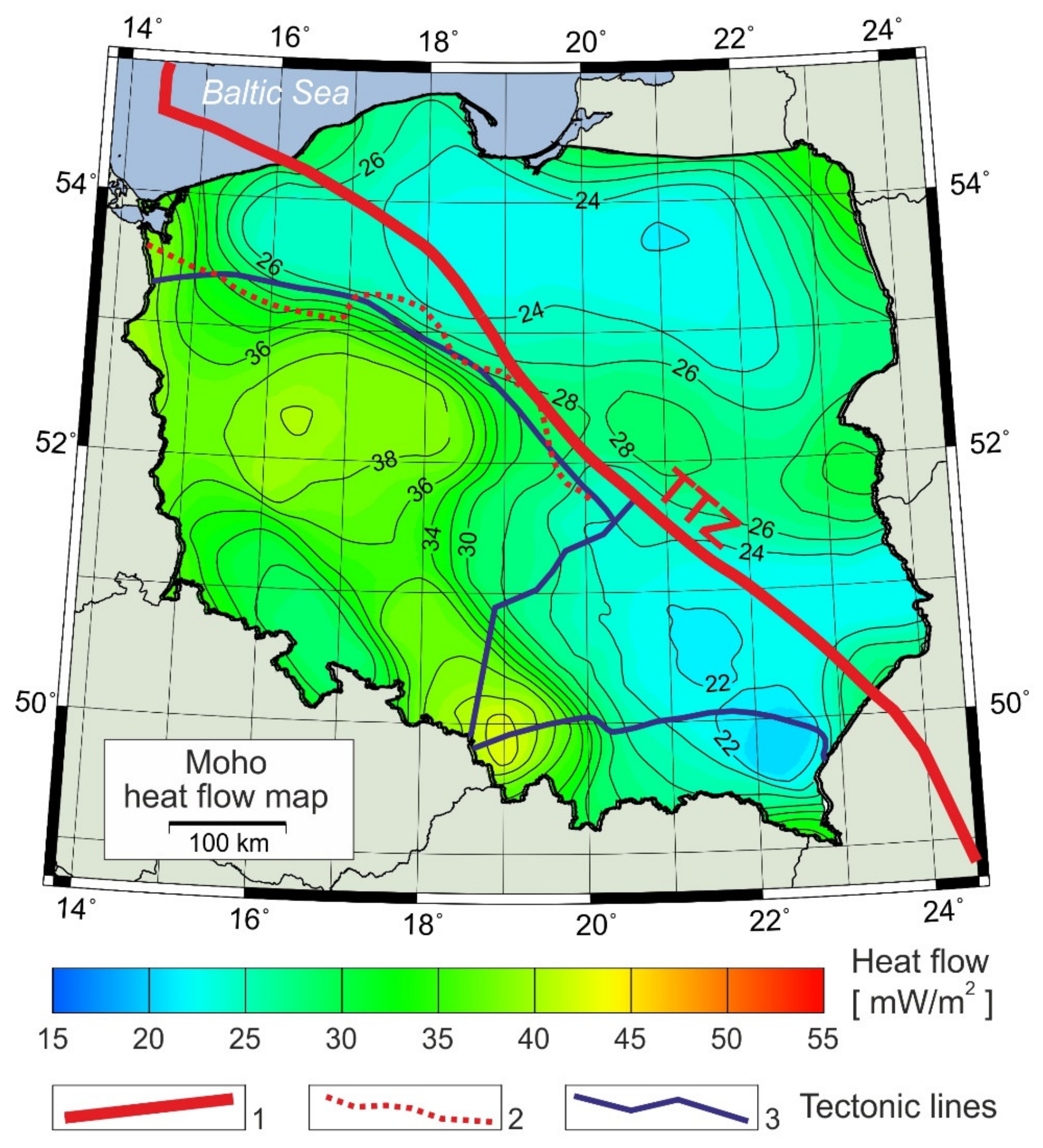
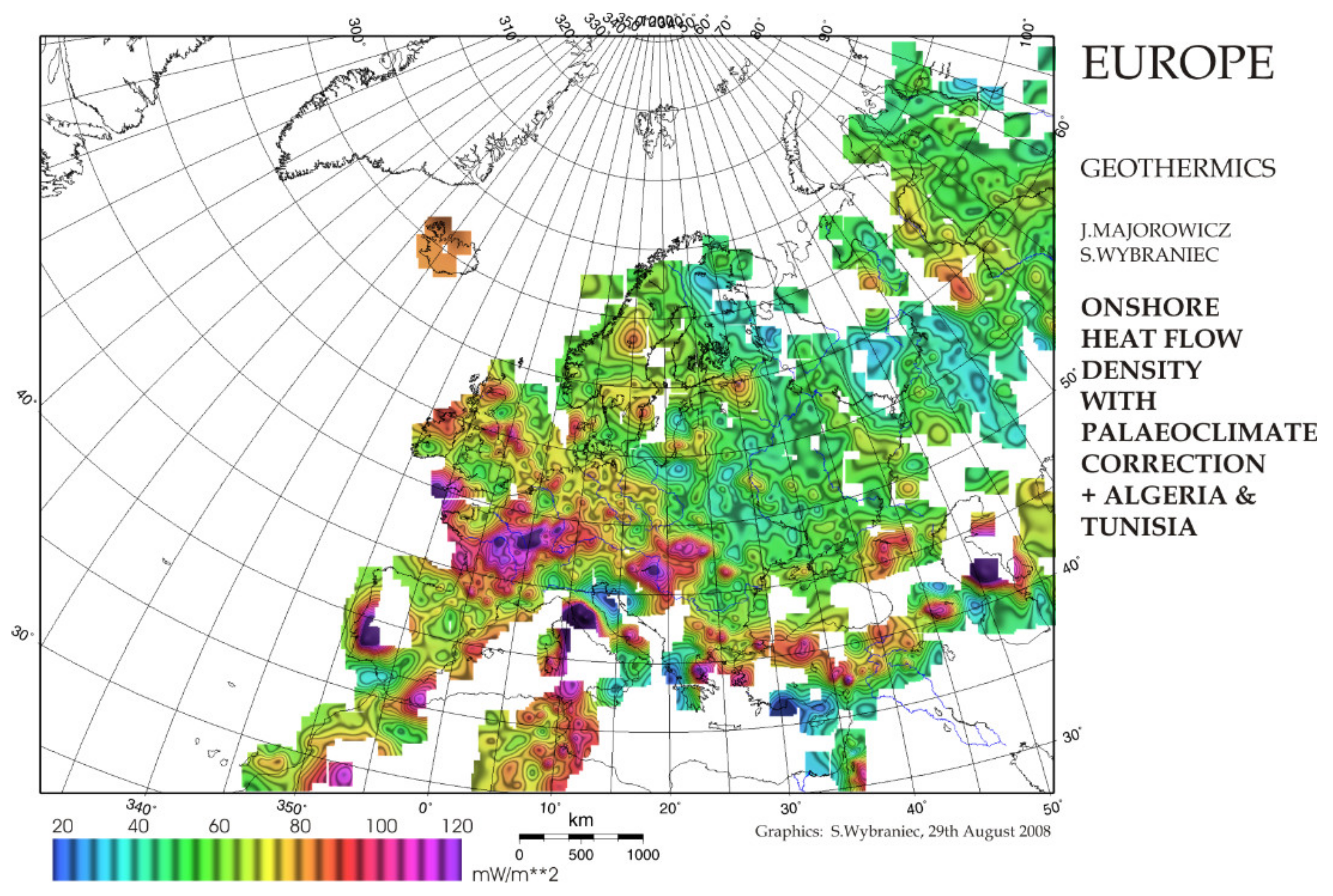
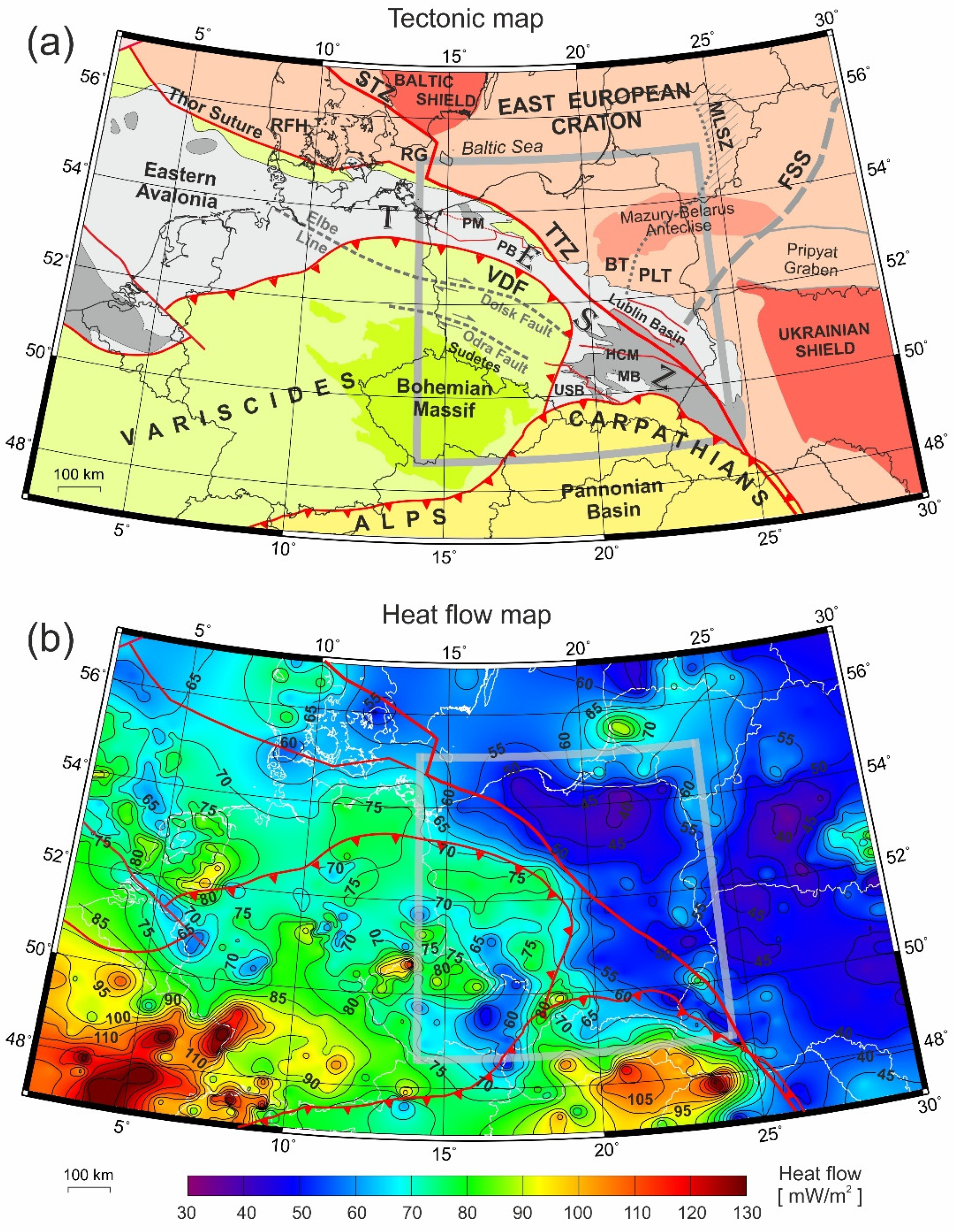
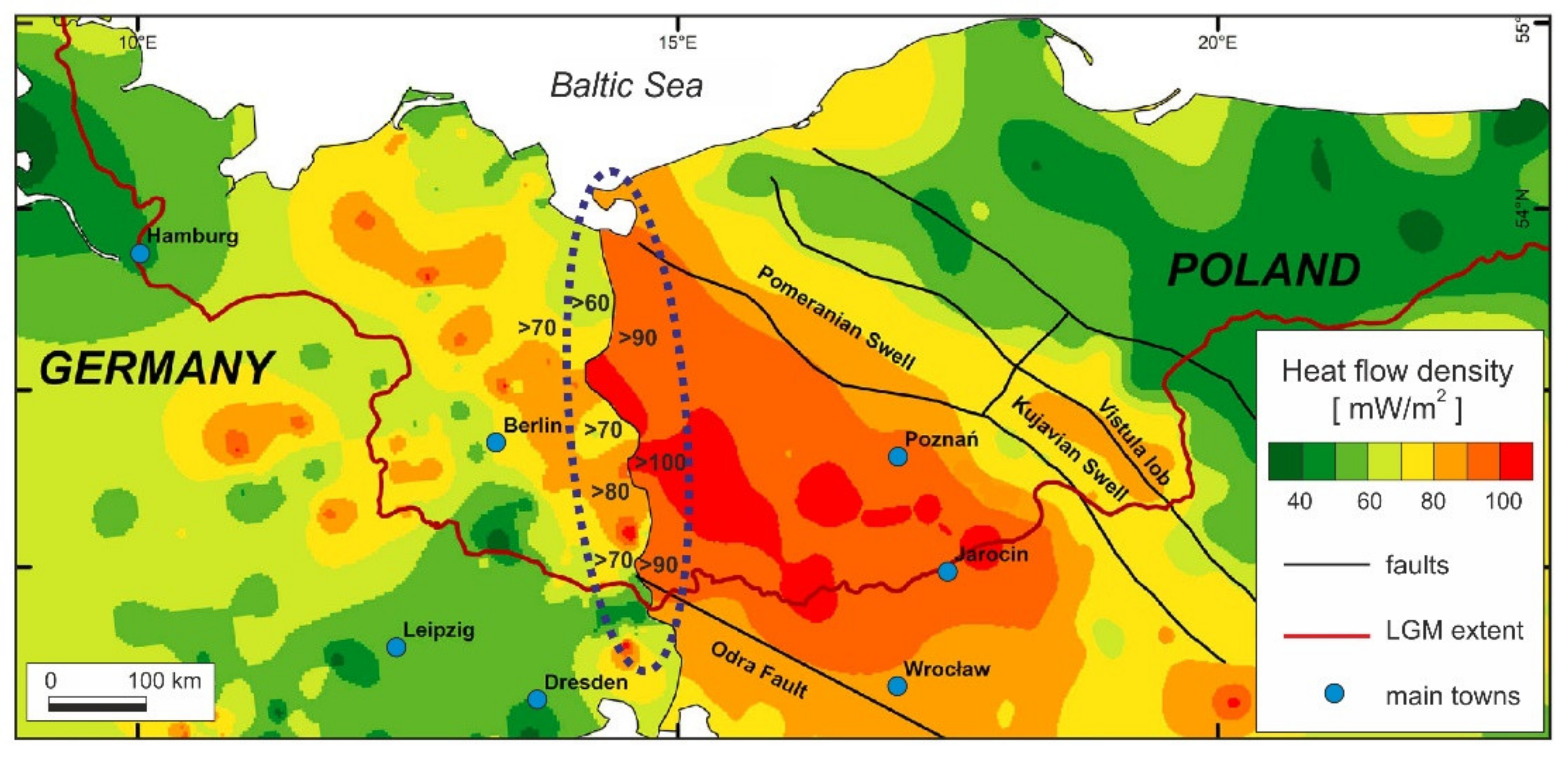
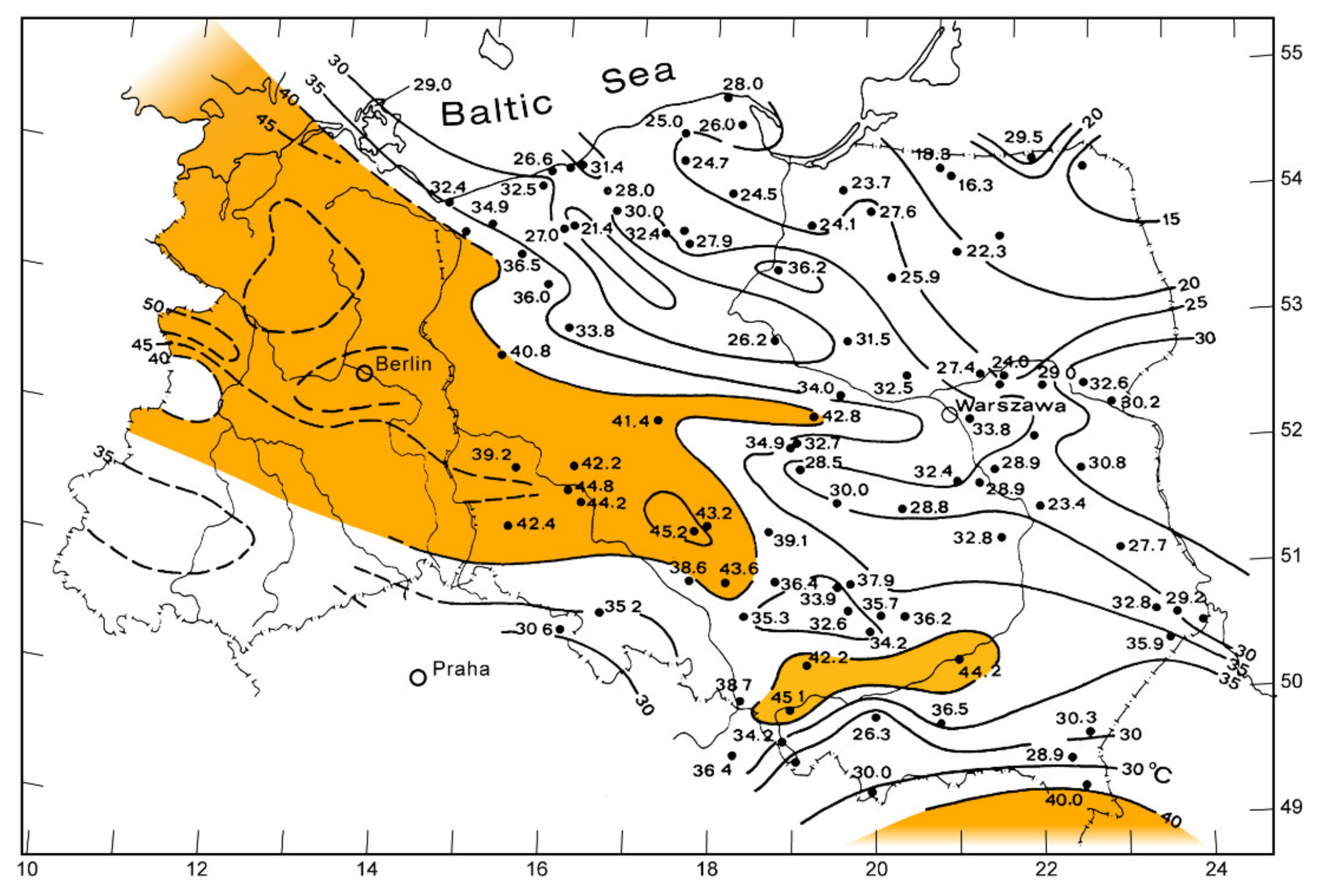
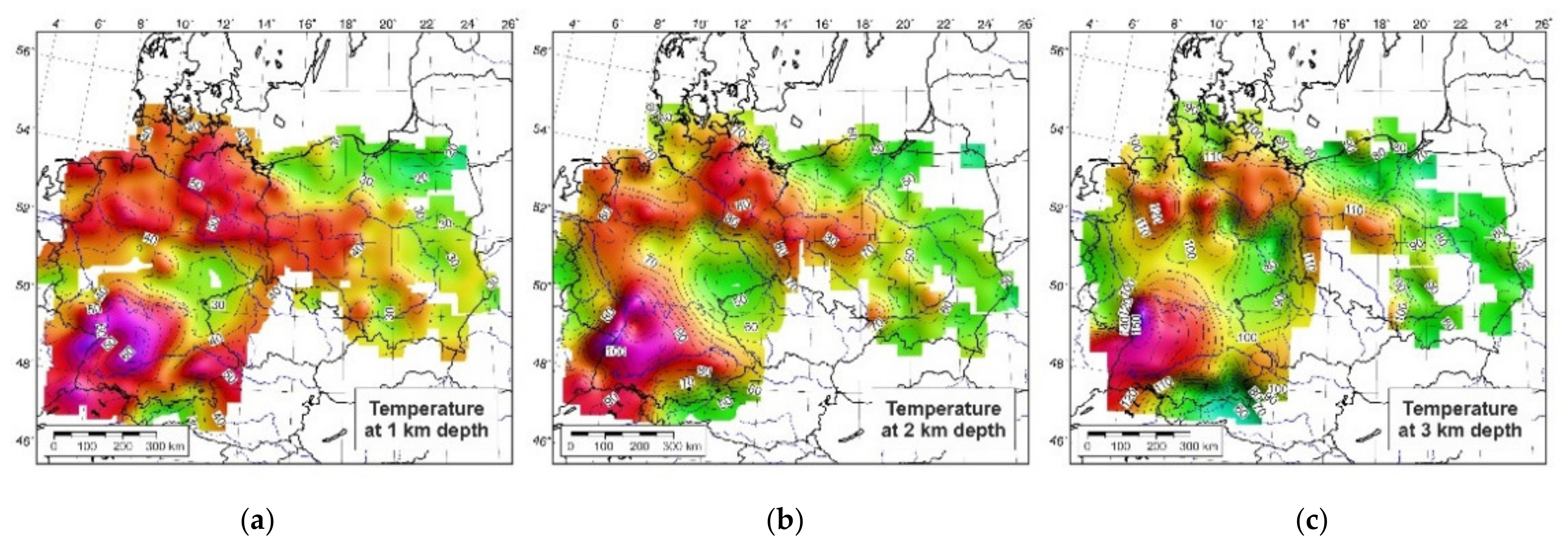
Publisher’s Note: MDPI stays neutral with regard to jurisdictional claims in published maps and institutional affiliations. |
© 2021 by the author. Licensee MDPI, Basel, Switzerland. This article is an open access article distributed under the terms and conditions of the Creative Commons Attribution (CC BY) license (https://creativecommons.org/licenses/by/4.0/).
Share and Cite
Majorowicz, J. Review of the Heat Flow Mapping in Polish Sedimentary Basin across Different Tectonic Terrains. Energies 2021, 14, 6103. https://doi.org/10.3390/en14196103
Majorowicz J. Review of the Heat Flow Mapping in Polish Sedimentary Basin across Different Tectonic Terrains. Energies. 2021; 14(19):6103. https://doi.org/10.3390/en14196103
Chicago/Turabian StyleMajorowicz, Jacek. 2021. "Review of the Heat Flow Mapping in Polish Sedimentary Basin across Different Tectonic Terrains" Energies 14, no. 19: 6103. https://doi.org/10.3390/en14196103
APA StyleMajorowicz, J. (2021). Review of the Heat Flow Mapping in Polish Sedimentary Basin across Different Tectonic Terrains. Energies, 14(19), 6103. https://doi.org/10.3390/en14196103




